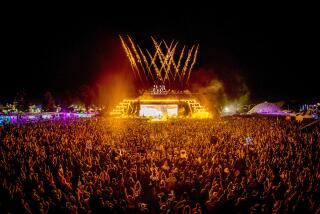Residents Shout to Be Heard About Noise at Lindbergh
- Share via
As at most center-city airports, jet noise from Lindbergh Field has been a cause of irritation--especially in San Diego neighborhoods and the military recruit depots near the flight path.
Nearby residents say the noise has been getting worse, especially in recent years with the number of flights increasing dramatically, and they have taken on the San Diego Unified Port District to fight for a bit more peace and quiet.
“If we don’t do something now to control it (airport noise), we’re not going to have any controls,” said Jerry Cluff, an attorney for the Airport Coalition, which represents residents and neighborhood civic organizations irked by Lindbergh noise.
Discontent over the noise has spawned a recent wave of lawsuits against the San Diego Unified Port District, Lindbergh’s owner. Filed in 1985 and still pending, the litigation alleges that jet noise has inflicted $200 million worth of property damage and emotional distress on 800 properties and 1,300 individuals living near the airport.
Use of Quieter Planes?
Residents, along with representatives of the Navy and Marines, also entered into negotiations with the Port District earlier this year to hammer out a plan to use more Stage III jets at Lindbergh--from about 50% of the take-offs and landings to 75% in 1993. The newer Stage III airplanes, such as the Boeing 747 and Lockheed 1011, are about 13 times quieter than the Stage II aircraft, which include the Boeing 727, considered the airline industry’s workhorse.
“It’s going to get better than it is now,” said attorney Michael Gatzke, who is defending the port against the noise suits. “As those 727s go out of service and we get newer airplanes, you are going to see some dramatic changes.”
Airport noise at Lindbergh first became an issue in the early 1960s, when jets began flying into San Diego. Port officials started monitoring the jet booms after 1979, when the state passed its noise law.
To measure noise, the port has placed 24 microphones in neighborhoods surrounding the airport. When a jet passes over a microphone, it lights up a board in the airport director’s office and feeds the noise level into a computer, which then stores the information to draw a contour map of the affected areas.
The contour map flares around the airport, theoretically showing in which areas the noise is considered to be “incompatible” with residential use. The maps include portions of the Loma Portal, Roseville, Midway District, Old Town, Hillcrest and Uptown neighborhoods.
What has alarmed residents most is that the boundaries of the maps have been expanding since 1981. A port study showed the area doubled between 1981 and 1984, said Cluff. Currently, the noise map encompasses 22,000 dwelling units and 14 schools located in the noise contours.
Port officials acknowledge that the maps have been getting bigger, but they say that is partly due to stricter noise standards adopted by the state. Originally, noise maps had to measure areas showing 80 decibels or greater; the newest maps start at 65 decibels.
But residents say Lindbergh noise is growing for more than just administrative reasons. They blame the increased number of flights at the airport. Since 1981, take-offs and landings have increased from 59,500 to 127,700 in 1987.
And while some quieter Stage III aircrafts have been phased in over the years, the increase in traffic means a greater number of the older, noisier 727s have been taking off from Lindbergh, said Cluff.
“It might be seven times an hour that the noise might be so loud that you can’t hear the TV in the room. Or you have to stop a conversation,” he said.
Cluff fears that with San Diego’s growth as a tourist destination, especially after the opening of the waterfront convention center, noise problems will only get worse. That’s why he stepped in and volunteered to help the Airport Coalition negotiate the plan for Stage III aircrafts at Lindbergh.
“This does not represent a detente between the Port District and Loma Portal,” said Cluff, who added that there is a “lot of distrust in the neighborhood” of airport officials.
“The view is they (the port) didn’t do it out of the kindness of its heart. They did it because something had to be done . . . rather than constantly fight the battle in open session with disgruntled residents.
“Ultimately, this problem is going to be addressed by moving the airport,” said Cluff.
Gatzke, meanwhile, said he suspects the latest spate of lawsuits against the port has been inspired, in part, by the recent speculation that it is time to relocate the airport.
“People will sometimes file lawsuits in an attempt to send a message about the seriousness of their concerns or to influence the decision-making process,” said Gatzke, who successfully defended the port against noise suits in the past.
But San Diego City Councilman Ron Roberts, whose district includes Lindbergh and its angry neighbors, said the noise problem probably won’t be a consideration if and when a new airport is opened. Public officials have said that even if an airport site were picked today, it would take at least another 13 years to plan and build the new airfield.
By that time, Roberts said, virtually all of the commercial airplanes flying into San Diego will be the quieter Stage III type.
More to Read
Sign up for Essential California
The most important California stories and recommendations in your inbox every morning.
You may occasionally receive promotional content from the Los Angeles Times.













